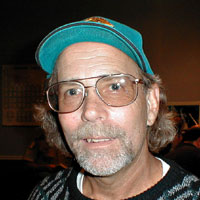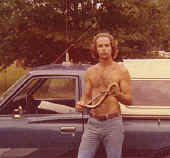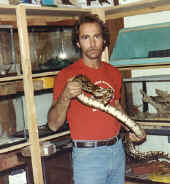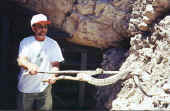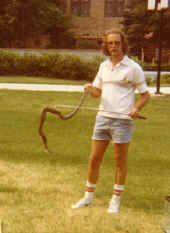MIKE: So when did you start getting ďseriousĒ about reptiles?
VIC: That would be during the pet store years. Most everything that came in was sick and in bad condition. There wasnít that many books out then and so I just had to do the ďfly-by-the-seat-of-my-pantsĒ method. But I did get in contact with the Jacksonville Zoo because I knew somebody there, and because of that, I kind of got on the zoo path of keeping things and was able to get information from different zoo people. And a few years later I met another person who actually worked during the Carl Kauffeld era. His name was Dennis McGee. He had a big rattlesnake collection and he was probably the biggest influence because when I saw how he kept a collection, like at a zoo, then I wanted to start doing it that way. He had a lot of experience working at zoos on how to keep them healthy. I kind of lost track of him. Heís out there somewhere. Because he had a big rattlesnake collection, soon afterwards, so did I. I named my first eastern diamondback rattlesnake ďDennis the Menace.Ē
MIKE: I met you in 1981. I was just out of high school and the reptile hobby was nowhere near what it is today. In the Ď70ís and early Ď80ís, people who kept snakes were thought of as weird. Did you ever envision the hobby turning into what it is now?
VIC: WellÖ..I donít think I envisioned it. Youíre right about that if you had a snake you were in the same category of someone who worked in the circus and there was this typical negative attitude about snakes. In the pet store, we got the typical remarks about snakes, ďI killed one like that in my yard last week.Ē They werenít anywhere near acceptable as they are now. IÖ.donít think I had envisioned it being like this.
MIKE: In light of the many changes worldwide what are your thoughts on the legal aspect of keeping reptiles?
VIC: Yeah. Thatís a heavy subject. If anything, weíve been lucky that nothing disastrous has happened locally such as a python killing somebody. There are some local laws in different cities that banned ownership of constrictors. A lot of them banned ownership of venomous reptiles. Weíve been lucky on that one. In recent times, because of being organized with the League of Florida Herpetological Societies, weíve pretty much fought off some pending legislation requirements for permitting, so weíve become more organized in this matter. Overall, I think our freedom to have this stuff is kind of under siege at any given moment and what we need to be watching out for is some kind of law that is passed when you are not notified or there is no opportunity to respond. So, uh, staying on top of legislation is important and fortunately Wayne Hill with the League of Florida Herpetological Societies pretty much stays on top of that. Now there is an industry advisory council and it is getting more organized every day. Weíre going to end up policing ourselves before the government comes in and tells us how to do it. Weíre hoping by doing it that way that things will be a little better. You always have to be suspicious of the government at all times because instead of taking away your freedom directly, they will do it indirectly by doing things like changing shipping requirements to make it so uneconomical that no one would do it. They are kind of sly and undermining in their actions. Thatís the kind of stuff we need to look out for.
MIKE: What are some of the more interesting species you have found?
VIC: Well, we almost caught that albino water snake (laugh); at least thatís what it looked like. I guess catching a 6 foot eastern diamondback [rattlesnake] (EDB) on a 95 degree day kind of sticks out in my mind. Thatís not a good time to catch a EDB. They are a little p.oíd. Really, it didnít matter what kind of snake it was. Whenever I caught one there was a certain thrill to it I was really into at the time. It was obsessive, like snake hunting every night after work for years on end. I worked construction. I was always on the edge of some undeveloped area. It wasnít unusual for the builders to come in and find the house that I was supposed to be working on completely empty, my radio going, and Iíd be out in the woods behind it. The guys at the supply house werenít too crazy about loading up the dry wall materials into the back of my truck because it rattled sometimes. I guess collecting at night and road riding sticks out as the majority of the time I caught snakes, as opposed to looking for them in the daytime just wandering through the woods. There was a lot of exciting stuff road-riding. I never found that albino eastern diamondback, but Iím still looking for it.
MIKE: What are some of the more interesting species you have kept?
VIC: One time somebody brought me a juvenile eastern diamondback rattlesnake that was an aberrant color phase. It was BLUE. Blue and black. It had no yellow pigment. It was quite striking after it shed the first time. It was beautiful. I did have it documented. It was one of two to this day that was caught that were blue and at the time one of only nine aberrant colors. But it didnít live although I tried very hard to get it to eat. It had been burned out from handling prior to me getting it. That was an interesting one. A 7í1Ē gray rat snake kind of sticks out in my mind. That was a whopper. Eastern diamondbacks; I had a captive breeding with Dennis the Menace. A lot of water moccasins. Water moccasins were funny. They would eat anything. I mean they would eat just anything. I always like the babies with the fluorescent tail that was a lure. I used to walk behind my house and find those things and even throw little frogs at them and actually see them eat in the wild. That was always fun.
MIKE: Have you ever been envenomated?
VIC: No. But I had some close calls Ė too close! Once a baby EDB hit me on the fingernail while I was putting the top on a container. I always took working with venomous snakes seriously, because having been in the hospital before for other injuries, I didnít want to go back. Once at a reptile conference I heard a crowd of guys talking about their snakebites. They seemed rather proud of it. I never wanted to be like them. It would be like a firearms expert bragging about shooting himself.
MIKE: What are your favorite reptiles?
VIC: Man. Thatís a hard one. I still think the red rat snake is one of the most beautiful Ė albino or not! I really liked my burms (pythons) even though they are labor intensive. The EDB (eastern diamondback rattlesnake)! Well, it looks like my favorites are the ones I have kept!
MIKE: You have some very nice outdoor enclosures. What prompted you to build these instead of just keeping everything inside?
| VIC: Thatís probably the zoo influence. Just seeing things outside in big enclosures always intrigued me. In 1980 I traveled around the country and visited a lot of zoos and decided that since I was slowly becoming a zoo, I would build some zoo-like enclosures. Itís really a good opportunity to see animals act a little more natural and especially in their thermoregulation processes. The first outdoor enclosure I built was for Jacksonís chameleons. And then some years went by and I just had small enclosures for tortoises. In the 1990ís I started breeding green iguanas. Actually, they hadnít been bred in captivity that often as early as 1990 and part of it was big enclosures that I had where they could act more natural. Theyíre never going to breed in a big aquarium. I donít care how big it is. So, just the idea of things being more reproductive. Iíve gone from a little 4ft by 8ft outdoor chameleon cage to 14,000 sq. ft. of enclosures for tortoises. |
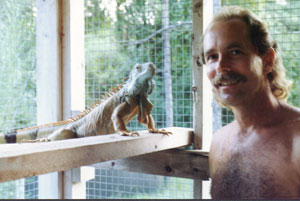 |
MIKE: How did you get involved with the Jacksonville Herpetological Society?
VIC: Well, actually prior to the Jacksonville Herpetological Society there was another herp society that was called the Florida Herpetological Society and was the only one in the state. And my friend Dennis Magee was running that. I was vice president one year and he kind of abandoned ship and left me holding it. The few years that it was around we had some very good speakers. We had Ross Allen speak a number of times and bring his photo albums of his whole life. We had Auffenberg speak right after he came back from the Komodo Islands. And Dr. Jacobsen. So we had some pretty heavyweight speakers, but the participation was a little wishy-washy and it kind of dwindled away. A few years passed and Dr. Rossi moved to Jacksonville and he got in touch with me and interviewed me for a book he was writing. Actually it was HIS idea to start a herp society. I donít think I wanted anything to do with it, but he was a pretty persuasive guy.
So for about 13 years, we can honestly say we have had an educational program going for over a decade. This will be our defense when some politician wants to outlaw pythons or something. I think being consistent is paramount in protecting out rights. I would have to say that over a period of time some of the results of this education have worked so well that people keep care of their iguanas so well that there are too many of them that are unwanted. Itís kind of a negative result from a lot of good work. Itís kind of ironic that once the information to care for them gets out they live longer and then people outgrow them. Thatís kind of an ironic little twist of fate. Another one is the fact that we actually have people who call us to come get snakes out of their yard instead of killing them. Iíd have never believed that 10 years ago. I think we hit some younger kids with this stuff and they educated their parents to stop running over snakes and killing them. That kind of blended in with the fact that, for whatever its worth, its kind of politically correct and fashionable to have concern for wildlife nowadays. We have that going for us. Itís not that we really had all these things in mind; it just materialized over the last decade or so. Through the reptile rescue, we have captured a lot of exotics, which is a sign that they have become more common, and therefore more mistakes will be made. Itís kind of the high price you pay for freedom. Like in Singapore, the way they dealt with the problem of people spitting gum out on the sidewalks was to outlaw gum. So gum is illegal in Singapore. So they donít have very much freedom over there. So here, if a few people make mistakes with their reptiles and they get loose, city fathers, in their wisdom think that just keeping them from everybody is the solution. Well, weíll have to straighten them out on that.
MIKE: In light of some of the venomous snakebites recently, mostly due to OUR encroachment on their habitat, what are your views on ecology and conservation?
VIC: Itís a hard thing for people to deal with. I would say that people are probably right or justified in killing a venomous snake if itís in their yard or around their kids. So I can see why they do it. Thatís not unnatural, but thereís some people that make an extraordinary effort to swerve off the road to run over a snake, or hunters that are always telling me about a cottonmouth that they shot while they were out hunting. Thatís just a malicious killing because they are in the snakeís neighborhood. I canít say much about the construction industry, because I make a living off of it and it would be foolish for me to condemn it, but planning could be done in a way without trampling anyoneís freedom. In recent times, I donít see that happening. I see peopleís property rights being violated and property being devalued. A lot of times all this environmental stuff to me seems very unconstitutional. I would rather see a freedom-oriented solution to our problems. One of them could be a plan similar to one a friend of mine, Tim Hoen does. He puts on an expo in Maryland every year. He takes all the money from the proceeds from the show and goes down to Costa Rica. Then he bids on the same land that the loggers are bidding on. He just outbids them. Them he purchases the land, donates it to the Costa Rican government and the people there can use it for a sustained use process, but they canít clear-cut it. I would like to see a program done like that that benefited some wilderness areas in the United States, but on a grand scale. But nothing like that seems to have materialized yet. Usually all the efforts restrict or invade peopleís constitutional right so until we get more visionary leaders, we are probably going to see more conflict between wildlife and humans looking for a place to live.
MIKE: Do you think there will ever be a solution?
VIC: I think there are some small things that are happening in this area that are not publicized, for example, one of the neighborhoods I work in the construction industry, the development in the neighborhood was such that each personís lot had a 300í evesment that they couldnít build on. They owned it, but could not build on it. And so, when these houses were back to back that left a 600í area of wilderness. So instead of going down a grid locked neighborhood, between each street was 600í property thatís just prime wetland. Itís just beautiful and so the people actually own it and can enjoy it. Thereís a lot of wildlife out there, so I think the development was successful in sharing the environment. This is right in the middle of the Deerwood area.
MIKE: So how long do you think you can hold out here at your property, with all of the construction activity in your neighborhood?
VIC: Well, I want to be one of those holdouts. My plans are to build a nature center out here. Iím getting closer and closer to the date that I wanted to do it. Iíd have to be offered an awful lot of money from somebody who wanted to come in here and build a parking lot or whatever, so Iíll probably end up staying here, and I hope that I can contribute to educating people on wildlife and be able to enjoy my animals and the conservation work Iím doing with the Turtle Survival Alliance. With a little luck, maybe it will pan out.
MIKE: Tell us a little about you nature center idea.
VIC: I already have this tortoise facility that people are starting to come from all over the United States to see of inquire about. Iím involved with a big conservation organization and have been assigned to write a proposal for the Species Survival Plan for Manoria emys. I have an assurance colony here for that organization. So, Iím really getting involved in the conservation of some Asian tortoises and I think I can combine that with some native Florida animals and possibly be able to survive out here myself selling produce and birdseed to neighborhood people and let the scouts do their programs. Iíd like to be able to work here fulltime with animals.
 |
MIKE: That sounds great. They just had a story on the news about there not being enough things for the kids to do in Jacksonville. VIC: Well, Iím just a couple of blocks away from a middle school. The neighborhoods here are attractive to those who are going to buy their first home, with a young family, because of the school close by, so I think it fits in there. Hopefully Iíll have an opportunity to keep breeding reptiles. But Iím going to have animals out here one way or another, so I might as well share the experience with other people. And you can get a BBQ dinner and some chips for $9.50. (laugh)
|
MIKE: When I met you in the early 1980ís, you kept mostly snakes, including venomous ones. Why the switch to turtles?
VIC: Well, what had happened was by the late Ď80ís I was getting a little bored with the snake collection. I had been collecting in the field and keeping snakes in aquariums for about 10 or 12 years. But all along, I have always had something outsideÖbox turtles, took a try at a couple of leopard tortoises and yellow-foots; had some chameleons outside. And so I always kind of had other reptiles going on the side, but snakes were the primary interest. I was getting bored with cleaning snake cages and so I started selling off most of my collection and I was doing some brokering of reptiles and wholesaling as a change of pace. I really didnít have a direction. Didnít know what I wanted to do. In that process, I acquired a pair of Burmese mountain tortoises that I fully admit that I just bought on impulse, knowing nothing about them. Broke every basic rule that we tell everybody else. That was in 1988 and I pretty much drifted straight full-fledged into tortoises. Havenít been snake collecting much since.
MIKE: Many of us are aware of the status now of your tortoises. What was their status in the wild when you got yours?
VIC: Well, they werenít imported very much. Probably because there wasnít really a demand for them. It wasnít a popular, charismatic tortoise for the pet trade. In every bit of literature Iíve every read on them, they were always referred to as scarce in the wild. They were used in the Asian cultures as a sustainable harvest for food until China gave them economic value.
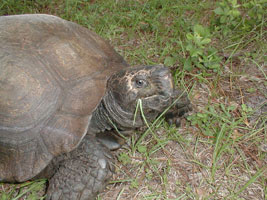 |
MIKE: Youíve been very successful breeding these tortoises. Tell us about it. VIC: Theyíve been bred in two US zoos and in Europe at that time. I believe mine was one of the few breeding by a private individual, so it was pretty rare. I have had consistent reproduction for over 10 years. The news media came out. They took a lot of good pictures, but got the text really confused. Then they did a follow up a year later, got the text right due to my persistence, but took lousy pictures. I guess I broke even (laugh).
|
MIKE: Who are some of the more interesting people you have met?
VIC: Dr. Rossi is one person. When I met Dr. RossiÖ..of course, one of the ways you get to become friends is you get together with a cooler and some brewskis and head out on the trail looking for snakes. So, I showed him all the places around here and we looked for snakes and over the years. He was writing his first book on snakes and wanted firsthand information on western snakes. He got some permits lined up to collect some snake out there in Arizona, so myself and some other people flew out to Arizona and met up with John (Rossi) and Roxanne who drove out, so we could document some snakes in the wild which later were in his book, ďThe Snakes of North America and Canada.Ē He had a list of snakes we had to find for his writings and he said the two rarest ones we probably wont find would be the Mexican vine snake, which lives right on the boarder of Mexico and Arizona and the other one is the rosy boa which hadnít been collected in the area that we were in for seventeen years prior to our visit. Around the second day, I was walking around on such a totally new environment to me. It was like being on the surface of the moon or something. Much different than collecting here in the swamps in Florida. A strange environment, but very exciting. I looked under a fallen tree and found a rosy boa. It was so odd, seeing a rosy boa. And I knew that was one that he really wanted so instead of yelling out, ďHey. I found a rosy boa,Ē I just calmly collected it up and walked up to Roxanne and really just calmly opened up my hands and said, ďWerenít yaíll looking for one of these?Ē Of course they both were just ecstatic and that snake eventually was bred in captivity and there were some offspring, and I think some of them were released back into the wild. And it was just a great collecting trip. Hereís a picture on the wall of us in this canyon. We saw a lot of wildlife and a lot of different snakes. I caught a big (6ft. +) salmon colored coachwhip snake. They are pretty fun to catch on a 100-degree day.
| We caught Mojave rattlers, several species of kingsnakes, and different hook-nosed snakes; things Dr. Rossi likes. And then one of the things I found out there that I really fell in love with was the desert iguana. I just had MORE fun catching desert iguanas and it was a hilarious time for a full-grown man trying to noose a little lizard. You had to laugh when you did it. Then, when you finally noosed them, (we had our little poles with the little noose on it) it was hard to keep from giggling and laughing and scare them away. When you finally did catch one, it was like catching your first fish. Sometimes you would jerk it too hard. I know thereís a couple of iguanas out there running around with some string around their neck that broke free. Dr. Rossi was shooting some of them with rubber bands, and kind of stunning them. Sometimes he would shoot a little too hard, he would pull out his little kit and give it some medicine. It was kind of hilarious. You know, we got pretty good at noosing them, me and John Brant. We had a rental car and put about 800 miles on it in just about a week or so, driving in a big circle in southern Arizona in the Sonoran desert. |
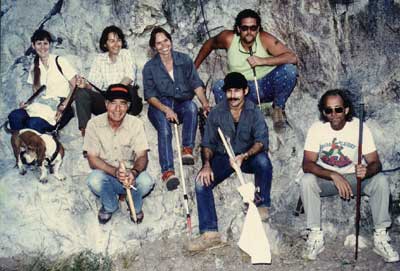 |
MIKE: Was this the famed ďAjoĒ Road?
VIC: Yeah, Ajo Road. The famed Ajo Road that Kauffeld wrote about. It was just amazing. We were active about 20 hours a day. We had a great time. A couple of funny things happened. We werenít familiar with the area so we left our campsite one day and previously we captured a bunch of tarantulas and scorpions to bring back to our friends. We had them in little deli cups. They blew all over the camp area where other people were staying. But they werenít overly excited or anything. Some little old lady collected them all up and told us not to leave our tent open. The wind comes by and these little gushes of windstorms come by. We learned that when we left the windows open in the car and it filled up with sand. My friend, John Brant, heís a big man. Heís not scared of too many things, but as we drove from Phoenix towards the Sonoran Desert, we were getting excited, it was at night and we knew we were getting close to the Sonoran Desert. Instead of like Florida and seeing little frogs on the road, which was always a good sign if you were road riding there, and you knew you would see some snakes. Out there, it would be the geckos on the road that would be good signs. So we started seeing the banded geckos on the road, and, being an old Everglades collector I said we needed to be looking under some of these culvert pipes.
MIKE: I think you drifted off the famous person question.
VIC: Oh yeah. I guess I did. You are stirring up some good olí memories. I met a whole room full of famous people in 1980 at a reptile symposium in Monroe, Louisiana at the Louisiana Purchase Gardens & Zoo.
MIKE: Thatís strange, Vic. I got a job in the reptile house there in 1996.
Back to home page
